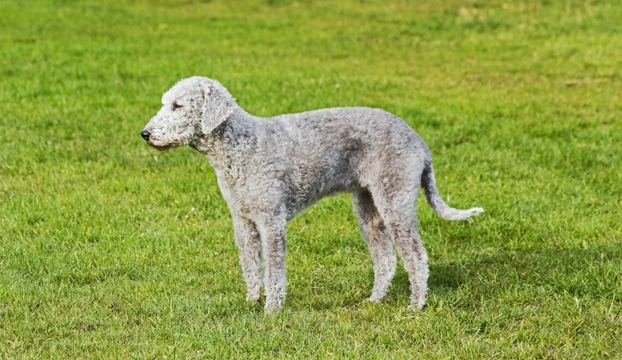
The unique and interesting temperament of the Bedlington terrier
The Bedlington terrier is a small terrier breed that is particularly distinctive for its very tightly curled coat, which forms a large topknot on the dog’s head and gives it a convex appearance that is unmistakable. They are reasonably popular as a whole in the UK, although they aren’t among the most common of dogs, falling just within the top third group of all UK dog breeds and types ranked by popularity.
As well as having a distinctive appearance, the Bedlington terrier also has a very distinctive personality to match, which is multifaceted and fairly complex. The breed is often considered to be a dog best owned by someone experienced with dogs and not a good choice for the first-time dog owner, due to the strength of their core traits and the complexity of their personalities.
However, if you are considering buying a Bedlington terrier and are willing to do plenty of research into the breed, there is no reason why they can’t make for a good match for even someone who has never owned a dog before, as long as you learn as much about them as possible from the get-go.
In this article, we will look at some of the Bedlington terrier’s core personality traits, and explain how they impact upon the dog’s care and management. Read on to learn more.
Speed and agility
Bedlington terriers fall around the middle of the pack when it comes to their need for exercise – they are not among the most challenging of breeds when it comes to ensuring that they get enough walks, but they are by no means couch potatoes either.
When they do exercise, they tend to be fast, active and lively, and they also tend to be quite keen on swimming as well as running around. They are nifty, agile little dogs that can reach a high running speed, and they do sometimes have a tendency to bolt off and be hard to recall.
They have a very precise and surefooted gait, and are capable of sharp turns and corners. They like interested, varied walks, and plenty of opportunities to run off the lead.
Intelligence
The Bedlington terrier is a reasonably intelligent dog breed, which often learns a lot through observation and repetition as well as by being taught specific commands. They require an incentive in order to follow commands, such as the promise of a reward for compliance – otherwise dogs of the breed can exhibit a lot of learned irrelevance, and tune out their owners and handlers.
Keeping the dog’s attention means being able to stay one step ahead of them and keep things interesting, and so training sessions are best kept short and varied.
Tenacity
Like most terrier breeds, the Bedlington terrier is a very tenacious dog, and once they start to concentrate on something it can be extremely difficult to break their focus. This trait is what made them such effective working dogs, as once they got the scent of something or engaged in a chase, nothing would divert them from their path.
Bedlington terriers still display a lot of this same tenacity within the domestic environment, and they may be prone to digging, burying things, and worrying at their toys, and can be hard to manage when it comes to getting them to leave something you don’t want them to have!
Prey drive
Again, as is the case with most terrier breeds Bedlington terriers have a very strong prey drive and can be prone to pursuing rabbits and other small wild animals when out on walks. This means that Bedlington terriers are also apt to chase cats, and so extreme care should be taken in terms of where you allow your dog to run off the lead, in order to safeguard other people’s pets.
Because Bedlington terriers are quite fast on their feet, they also stand a good chance of actually catching their targeted prey too, and it can be virtually impossible to part them from it.
Keep your dog on a lead any time there are or might be small animals around, and consider muzzling them when off the lead if they do display a propensity to chase things.
Dominance
Bedlington terriers are plucky, bold dogs, which will naturally take the pack leader position if a strong leader is not already in place. This can extend to the status quo within a home situation, and so it is vital that Bedlington terrier owners ensure that their dogs know who is in charge, and respect their authority.
Nip any pushy or dominant behaviour in the bud early on to prevent later problems, and make sure that your dog displays good manners and knows their place within the pack structure of the home.
Socialisation with other dogs
Bedlington terriers are playful and generally social with other dogs, but their instinctive tendency to dominance can also manifest with other dogs too. Appropriate socialisation from an early age is particularly important for Bedlington terriers, and they must not be permitted to show aggression or excessive dominance around other dogs.
Bedlington terriers are almost fearless when it comes to standing their ground and facing up to even much larger dogs, and if a flashpoint arises and a Bedlington terrier becomes aggressive, they will be very forceful and can potentially cause significant harm to the other party.
Again, teaching and enforcing clear rules and managing socialisation carefully from an early age can help to prevent problems of this type.



